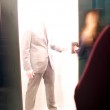
© Trisha Brown, Walking on the Wall, 1971 at the Whitney Museum © Carol Goodden
Barbican (London) Opens New Exhibit: “Laurie Anderson, Trisha Brown, Gordon Matta-Clark: Pioneers of the Downtown Scene, New York 1970s“
The work Laurie Anderson created while living in downtown New York City in the 1970s is inextricably linked to the place and time in which it was made. These are the focus of a new exhibit opening today at the Barbican Art Gallery in London titled Laurie Anderson, Trisha Brown, Gordon Matta-Clark: Pioneers of the Downtown Scene, New York 1970s.
The new exhibit, which runs through May 22, is the first major presentation to examine the experimental and often daring approaches—from dancing on rooftops to cutting fragments out of abandoned buildings—taken by these three leading figures in the rough-and-ready arts scene developing in downtown Manhattan during the 1970s. Anderson, choreographer Trisha Brown, and artist Gordon Matta-Clark were friends and active participants in the New York art community, working fluidly between visual art and performance.
The exhibition, curated by Lydia Yee, brings together around 160 works by Anderson, Brown, and Matta-Clark, many rarely seen, with some presented for the first time outside New York. Featuring sculptures, drawings, photographs, films, live performances and mixed media works, as well as posters, documentation and other ephemera, the exhibition focuses on the intersections between their practices and explores their mutual concerns—performance, the urban environment and an emphasis on process and experimentation.
New York City provided a powerful context for the work of Anderson, Brown and Matta-Clark. On the verge of bankruptcy in the 1970s, and faced with the disappearance of manufacturing industries, the city was turning into a centre of widespread unemployment and lawlessness. In search of large, cheap spaces, artists responded by converting derelict buildings into live-work lofts, to make and exhibit their work. These artists sought to distance themselves from the dominant artistic movements of the 1960s, Pop art and Minimalism, in which the object was paramount. Taking art out of the conventional gallery context and performance off the stage, they used the city as the setting for their work. Performances took place in the streets, on buildings and in the cavernous artist loft spaces in downtown New York.
Some of Laurie Anderson’s earliest works took place in downtown New York and were informed by conceptual and street performance. For Institutional Dream Series (1972), Anderson slept in public places in an attempt to determine if specific sites influenced her dreams. Anderson’s early work introduced the combination of image and text that remain a constant narrative device throughout her work. Also on view are a number of her early sculptural works that foreground her interest in storytelling and experimentation with sound.
For more information on the exhibit, visit barbican.org.
New York Magazine recently did an interview with Laurie Anderson about her take on New York and Donald Trump.
(originally published on nonesuch.com)

 RSS
RSS
